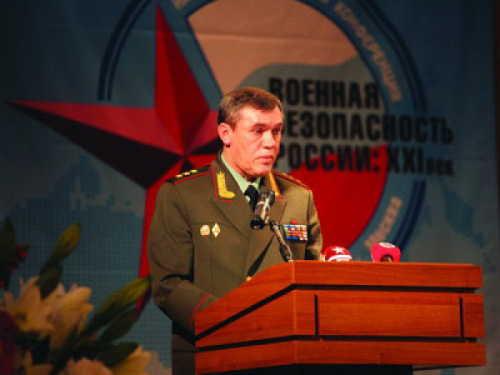
Gerasimov Links Russian Military Modernization to the Arab Spring
Publication: Eurasia Daily Monitor Volume: 10 Issue: 41
By:

Russian President Vladimir Putin told the defense ministry collegium on February 27 that the Armed Forces must reach a “new level” of capability within five years, due to the “dynamics of the geopolitical situation.” Putin’s language concerning defense transformation displays a preference for terms such as “forming” rather than “reform” to characterize the changes in the Armed Forces since 2008. Similarly, Defense Minister Army-General Sergei Shoigu sets the main defense task as “capacity building,” drawing a line under the period of reform (Nezavisimoye Voyennoye Obozreniye, March 1; https://www.kremlin.ru/news/17588).
Yet, while the language concerning reforming the Armed Forces has shifted, it remains clear that further changes will be required to meet targets by 2018. Putin referred to the “Defense Plan” drawn up by 49 departments and presented to him in late January by the Chief of the General Staff, Army-General Valeriy Gerasimov, which he recently signed into law—serving as a basis to justify further adjustments in the military. “The Plan to Defend the Russian Federation to 2016” is a classified document and is not meant to replace the 2010 Military Doctrine (https://www.kremlin.ru/news/17588).
Sources in the presidential administration told Jamestown, however, that the “Defense Plan” is an operative plan of the Armed Forces, delineating the powers of the defense ministry in terms of natural and man-made disasters, combating terrorism, the modernization of the military and defense industry, mobilization plans for the national economy, and mobilization of the Armed Forces, as well as threat assessment and deterrence. The law apparently contains detailed military and security plans, unlike the publicly open security documents. Consequently, it will be redrafted and revised every five years. It remains unclear why this new law was deemed to be necessary, but Putin is using it to push through further military transformation linked to an undisclosed threat assessment.
One clue about how the General Staff in particular perceives the threat environment as well as shifts in the means and methods of modern conflict lies in the speech delivered in late January 2013 by Gerasimov to the Academy of Military Sciences. Gerasimov’s report covered “The Main Trends in the Forms and Methods of the Armed Forces,” and focused on how military science can play a vital role in achieving advances in military capability. He began by noting that the distinction between war and peace has blurred in the modern era, and referred to the sudden explosion of unrest or color revolution that erupted in North Africa and the Middle East. The Arab Spring has resulted in foreign intervention, chaos, humanitarian disaster and civil war. Although, as Gerasimov observed, the Arab Spring does not constitute war in the traditional sense, he posed the question as to whether such turbulence may become the “typical war” of the 21st century. Here, the chief of the General Staff notes that this new type of conflict has devastating social, economic and political results comparable to war (https://www.vpk-news.ru/articles/14632)
He posed the questions: What is modern war? And how should the Army be prepared and armed? Gerasimov explained that the means and methods of modern conflict have fundamentally changed, marked by intelligence and dominance of the information space. Information technologies have reduced the “spatial, temporal and information gap between army and government.” Objectives are achieved in a remote contactless war; strategic, operational and tactical levels or offensive and defensive actions have become less distinguishable. Asymmetrical action against enemy forces are commonplace, while the means and methods of applying force are being constantly improved (https://www.vpk-news.ru/articles/14632)
Gerasimov reminded his audience of the changes in approaches to combat in 1991 during Operation Desert Storm, the 2003 intervention in Iraq and current plans by the United States to develop conventional weapon “prompt global strike” capability as Washington consolidates its doctrine of globally integrated operations. His speech touched upon Western operations in Libya—creating a no-fly zone, augmented by a naval blockade and closely collaborating with the opposition and private military companies. Gerasimov called on Russian military science to place itself at the forefront of shaping and developing views on such challenges and assisting the military in its transition into the information era. One example of where the Academy of Military Sciences is currently actively engaged in such work relates to the development of the Aerospace Defense Forces (VKO). But this must go much further in his view. Military science must promote Russian approaches to modern conflict, rather than merely emulating foreign experience. Gerasimov, therefore, referred to the Soviet military scientist Aleksandr Svechin, who highlighted the unique nature of every conflict and how any new conflict requires the formulation of its own logic. Gerasimov concluded that due to these changes, the risk has increased that Russia or its allies may be dragged into conflict (https://www.vpk-news.ru/articles/14632).
Gersimov is clearly advocating the adoption of Command, Control, Communications, Computers, Intelligence, Surveillance and Reconnaissance (C4ISR) as the future developmental path for the Russian military, and he has some intellectual heavyweights fully supporting his argument. Former Deputy Defense Minister and academician Andrei Kokoshin recently published “O sisteme neyadernogo (pred’yadernogo) sderzhivaniya v oboronnoy politike Rossiiy” (“A system of Non-Nuclear [pre-nuclear] Defense Policy of Deterrence in Russia”). In this work, Kokoshin develops and justifies his stance on the need for non-nuclear deterrence. He argues that for the foreseeable future Russia will have no alternative within the international system to nuclear deterrence, but important changes are needed nonetheless. He describes non-nuclear deterrence as involving high-precision long-range conventional weapons, based upon new physical principles and highly advanced information and communication systems. Possessing such capabilities would be an important “means of preventing escalation dominance” by an adversary during “an acute political and military crisis.” Kokoshin also argues that a system of non-nuclear deterrence should be conceptualized in Russia’s Military Doctrine (Krasnaya Zvezda, February 8).
Such a system of non-nuclear deterrence does not yet exist in Russia. Advocates of network-centric capabilities are increasingly framing their arguments in terms of the lack of conventional options at the disposal of the Russian state during a future escalating international crisis (see EDM, February 26, 19). Although the defense plan is secret, it is likely to acknowledge precisely the types of issues highlighted by Gerasimov linked to the changing nature of conflict and the suddenness of unforeseen crises. Putin’s “new level” of military capability within five years may be a signal that fresh changes to force structure and manpower will be made to prepare the Armed Forces for the gradual introduction of C4ISR.




